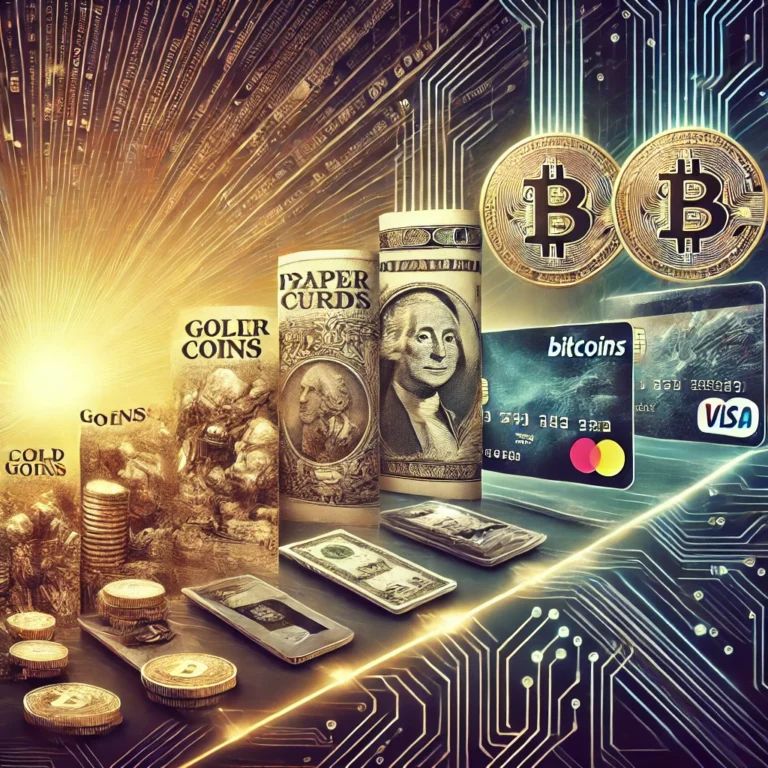Evolution of Money
Money, the lifeblood of human civilization, has undergone a remarkable transformation over the centuries. From gleaming gold coins to invisible digital tokens, we’ve witnessed an incredible evolution in how we store and exchange value. In this comprehensive guide, we’ll take you on a fascinating journey through the history of money, exploring how technological advances and societal changes have shaped our financial systems.
The Age of Precious Metals (1000-1500 CE)
Gold and Silver: The Original Standard

In medieval times, precious metals dominated the monetary landscape. Gold and silver coins were the preferred currency due to their:
- Intrinsic value
- Durability
- Portability
- Universal acceptance
The Rise of Trade and Banking
During this period, we saw the emergence of:
- Merchant banking in Italy (Italian merchants, like those from the Medici family in Florence, were pioneers in establishing merchant banks, providing credit and managing deposits for other traders, facilitating trade across Europe).
- The first letters of credit (The first letters of credit (LCs) were developed in ancient Mesopotamia and Egypt, and used in Europe in the 1800s. ).
- International trade routes establishing new monetary systems
The Paper Revolution (1500-1900)
Birth of Paper Money
The Chinese were pioneers in paper currency, but European nations soon followed suit. Key developments included:
- Bank notes backed by precious metals
- Government-issued currencies
- The establishment of central banks
The Gold Standard Era
The late 19th century saw the formalization of the gold standard, creating:
- Stable international exchange rates
- Predictable monetary policies
- Global trade facilitation
The Modern Banking Era (1900-1971)

The Federal Reserve and Central Banking
The creation of modern central banks revolutionized monetary policy through:
- Interest rate control
- Money supply management
- Economic stability measures
Bretton Woods and International Monetary Systems
Post-WWII developments included:
- Fixed exchange rates
- The US dollar as global reserve currency
- International monetary cooperation
The Digital Revolution (1871-2000)
Electronic Money and Banking
The rise of computers transformed financial services with:
- Electronic fund transfers (The first electronic fund transfer (EFT) was introduced in 1871 by Western Union. The first widely used wire transfer service was also launched by Western Union in 1872.).
- Credit card systems (The first credit card systems were charge cards that began in the early 1900s . The first modern credit card, the Diners Club Card, was introduced in 1950).
- ATM networks (Barclays–De La Rue machine: The first ATM, invented by John Shepherd-Barron and his team at De La Rue Instruments Ltd. It was installed at the Enfield branch of Barclays Bank in London in 1967.).
The Internet Banking Boom – Online banking introduced:
The first online banking platform was created by Wells Fargo in 1995. However, the origins of online banking can be traced back to the 1980s when banks began experimenting with fax machines and telephones for transactions.
- 24/7 account access
- Digital payments
- Mobile banking solutions
The Cryptocurrency Era (2009-Present)

Bitcoin: The Pioneer
The 2008 financial crisis sparked a revolution with Bitcoin’s introduction, featuring:
- Blockchain technology
- Decentralized networks
- Peer-to-peer transactions
The Crypto Ecosystem
Modern cryptocurrency developments include:
- Smart contracts
- DeFi (Decentralized Finance)
- NFTs (Non-Fungible Tokens)
Future Trends and Predictions
Central Bank Digital Currencies (CBDCs)

We’re witnessing the emergence of:
- Government-backed digital currencies
- Hybrid monetary systems
- Enhanced payment infrastructure
The Future of Money
Anticipated developments include:
- Integration of AI in financial systems
- Quantum-resistant cryptocurrencies
- Universal digital payment systems
Frequently Asked Questions (FAQs)
Q1: What made gold such an effective form of money? A: Gold’s durability, scarcity, divisibility, and universal acceptance made it an ideal store of value and medium of exchange.
Q2: Why did paper money replace gold coins? A: Paper money offered greater convenience, easier transportation, and better scalability for growing economies.
Q3: How does cryptocurrency differ from traditional currency? A: Cryptocurrency operates on decentralized networks, without central authority control, using blockchain technology for security and transparency.
Q4: What are CBDCs and why are they important? A: CBDCs are digital versions of national currencies, offering the benefits of cryptocurrency while maintaining government oversight and stability.
Q5: Is physical money becoming obsolete? A: While digital payments are increasingly dominant, physical money still serves important functions in many economies and isn’t likely to disappear entirely soon.



Very informative, please keep it up!